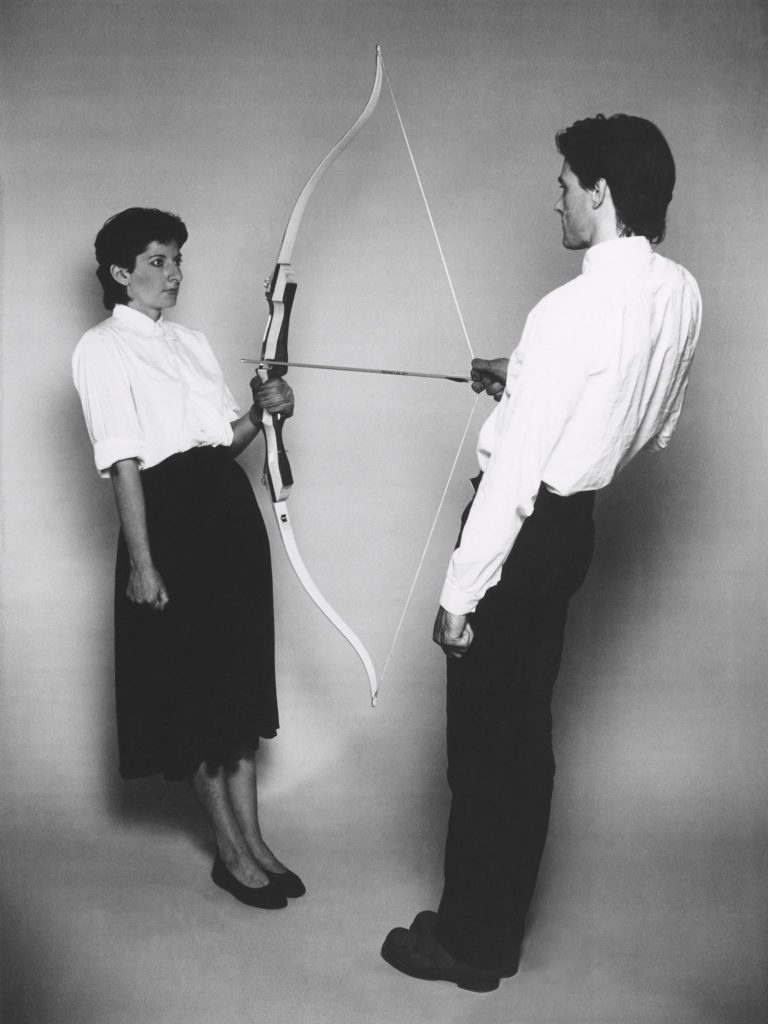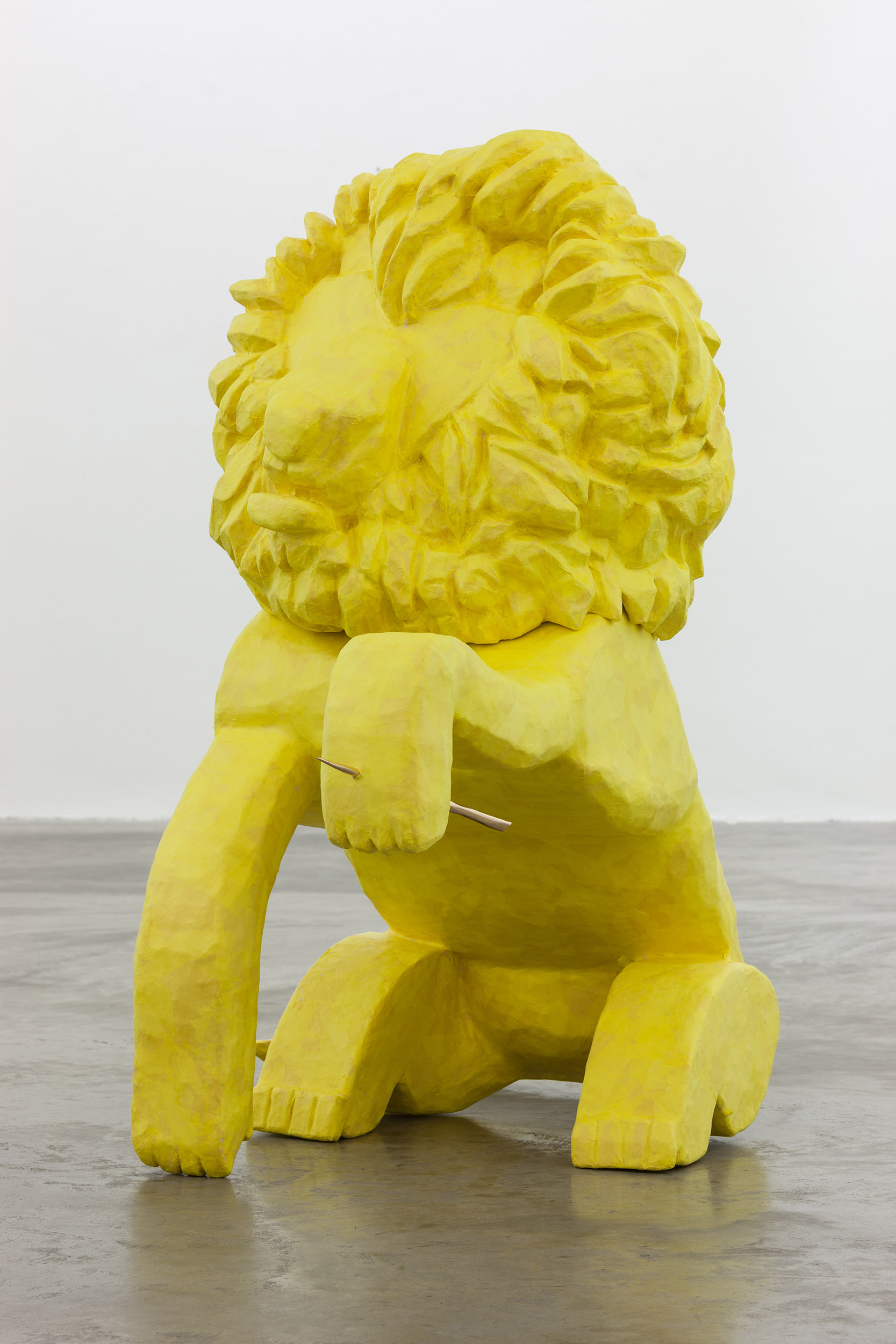Beneath a room-sized canopy of sewn-together clothing – a loose assortment of arms and legs flopped downwards like so many stalactites – and wearing a black frock coat, Amanda Coogan moved slowly through a set of pre-configured routines. Beethoven’s music came from somewhere outside the tent-like structure, a music that, eventually, the artist began to conduct, or at least mime conduct, since there was no causal connection between her gestures and the pre-recorded sound – or rather, there was a connection but her gestures were a response to the music instead of the other way round. After twenty minutes I was bored, but also curious, opposing feelings I’ve often experienced with art. Still in the first section of a two-part performance, Coogan takes her time, and this would take two hours. From across the room, an impatient friend signalled he was leaving. His hasty exit made me more determined to stay.
Coogan is the child of deaf parents. Her first language was sign language. Interviewed in 2015 for the TV programme The Work Presents, Coogan told John Kelly how she had considered going to Trinity College and doing drama but had chosen the non-verbal route instead, ‘And not just the non-verbal,’ she added, ‘but the visual … I needed to make images.’1 In the same programme, Coogan is shown bending over a large canvas laid on the ground. From a bucket and plastic bottle in turn, she flings and squirts liquid paint onto the unstretched fabric, à la Jackson Pollock. She explains how the choreography of mark-making led her to performance, because ‘the activity of making was much more interesting to [her] than the end product’.2 Though these foundational moments seem at odds – the desire to make images, set against a preference for action over outcome – she has continued in this vein ever since, producing striking tableau using her own body as a primary means, combined with intense durational performances based on shared moments in specific places and times.
Ulay / Marina Abramović, Rest Energy, ROSC’ 80, Dublin, 1980. Performance for video, 4 minutes. © Ulay / Marina Abramović.
By the time Coogan began making performances in the early noughties, a significant performance-art scene was already well established in Ireland. Influential figures included Nigel Rolfe in Dublin and Alastair MacLennan in Belfast. Perhaps more significantly for Coogan, prominent female artists such as Alanna O’Kelly and Pauline Cummins were establishing a legacy of Irish performance art based on feminism and the female body.3 Outside of Ireland, important forbears included American artists like Carolee Schneemann and Hannah Wilke, and the Cuban–American Ana Mendieta, who, all coming to prominence in the 1960s and ’70s, made visceral, body-focused art putting feminist issues at the heart of their practices. For Coogan’s practice, however, the most important figure was the Serbian artist Marina Abramović, whom she eventually studied under at Hochschule für Bildende Künste, Braunschweig, in Germany.4
Abramović, together with Ulay, her then life and artistic partner, performed Rest Energy for ROSC 1980 in Dublin. Coogan was too young to witness this performance for herself, but the subsequently famous piece – with Abramović standing at the sharp end of a tautly suspended arrow and bow – became, like many performance works, important as an idea and visual record as much as a live performance. While most performance art is dedicated to the co-presence of artist and audience, the memory and retelling of such shared events is also a vital component. During 2022, in a series celebrating the fiftieth anniversary of the publication of John Berger’s Ways of Seeing on BBC Radio 4, describing a performance by Coogan, Sinéad Gleeson noted the importance of ‘the permanent record of a performance that is rooted in its own impermanence’.5 The unrepeatability of a live performance makes the recording of it additionally vital. Without denying their validity in the immediacy of the here and now, performances, like most artworks, continue to unfold their meanings through changing times and repeated descriptions and iterations. Contexts change, after all, and so do we. Duchamp called art a ‘habit-forming drug’, but sometimes the intoxication comes later.
Amanda Coogan, How to Explain the Sea to an Uneaten Potato, 2008. Live performance, Bull Walk, Dublin. Duration: 4 hours. Courtesy of the artist.
In some respects, Freude! Freude! looked like a regular exhibition. The tall gallery space was cut in half by the enormous patchworks of sewn-together clothing that stretched across the width of the room (later, as Coogan began to raise and lower these fabrics on ropes, it felt as if we were all under sail). Such physical interventions are not unusual in the gallery, but what made Freude! Freude! different was its schedule of live performances. Coogan usually works alone or in small ensembles. In Yellow (2008–10), for example, the artist sits astride a wash-tub wearing a dress made of several metres of yellow fabric, bunching, scrubbing, and ringing out the skirt in a Sisyphean spectacle of thankless labour. A commentary on the historically undervalued nature of domestic chores, perhaps, but for an Irish audience in particular, the infamous Magdalene Laundries will also come to mind. In How to Explain the Sea to an Uneaten Potato (2008), Coogan riffs on How to Explain Pictures to a Dead Hare (1965), an iconic gallery performance by Joseph Beuys. Like Beuys, Coogan sits with her head covered in gold leaf, but instead of honey, she is garlanded with potatoes, and facing out to sea from a bathing shelter on Fairview Strand. Both of Coogan’s works are typical in how they reference other artworks – Yellow seems loosely connected to Abramović’s Cleaning the Mirror (1995) and Balkan Baroque (1997) – while recontextualising them to resonate with aspects of Irish history. In works like these (both Coogan’s and her mentors), the isolation of the performing figure in front of an audience is essential to their effect. In Freude! Freude! these dynamics were different. Throughout the performance, Coogan is clearly in control, not isolated and vulnerable, but the dynamic doyenne of a troupe of silent collaborators.
Amanda Coogan, Yellow, 2008. Collection Irish Museum of Modern Art, Purchase, 2021. Yellow was performed in I’ll sing you a song, RHA, Dublin, 2015. Photo: Paddy Cahill.
The West-Eastern Divan Orchestra was founded in 1999 by Argentine–Israeli conductor and pianist Daniel Barenboim and Palestinian–American academic and critic Edward Said. The two friends sought to promote collaboration through music as an antidote to political conflict. Watching the orchestra perform Beethoven’s Symphony No. 9 on YouTube, I was struck by a moment when, as a prelude to the choral section, the so-called ‘Ode to Joy’, the massed ranks of singers who have quietly sat behind the orchestra for almost an hour suddenly rise.6 Following Coogan’s solo conducting, a similar unspoken drama occurred in the Douglas Hyde Gallery, when, one by one, and seemingly from nowhere, members of the Deaf Choir quietly descended the stairs and formed themselves into lines. I thought of school children lining up for class, and as individual performers flexed in readiness, of athletes waiting for the starting gun.
In Beethoven’s symphony (he himself was deaf by the time of its composition), the choral starts with a solo bass, ‘O Freunde, nicht diese Töne!’ (O friends, not these sounds!), before singing the opening lines of Friedrich Schiller’s poem (upon which the choral section of the symphony is based). The singer pleads for pleasant and joyful sounds. ‘Freude!’ he insists, and the whole choir responds, ‘Freude! Freude!’ (Joy! Joy!). There’s no mention of these details in the presentation of the work in the gallery, but the exhibition title leaves you in no doubt what’s at stake. A recording of Beethoven’s music is played through the gallery sound system at an uncomfortably loud volume. Beneath the false ceiling of clothing, and among the shadows thus created, the gestures of the performers, energetically conducted by Coogan, are almost eerily dramatic for their contrasting silence. After a while, some of the ‘singers’ (more properly ‘signers’) fall a little out of sync with each other. As small gaps appear in the visual choreography, an erratic counterpoint of signals and sounds becomes a fascinating glitch, like a moiré pattern in the moving air. The loud, pre-recorded music plays on, while the Deaf Choir produces its own, visual music, with accompanying idiosyncrasies. There are several sections within the choral arrangement. As each one finishes, the singers drop their arms to their sides and momentarily relax. In the silence, their breath is audible. I thought of Samuel Beckett’s Breath (1969), a play without words, and lasting only thirty-five seconds. The play begins and ends with a soft cry – in a note to his publisher, Beckett uses the term ‘vagitus-rattle’, suggesting both birth and death cry – with only amplified breathing in between.7 In the gallery, as the deaf chorus exhales, their punctuations of breath both signal and create the silence that follows. A quiet register, I thought, experienced differently by each one of us.
Amanda Coogan, Freude! Freude!, 2023. Documentation of live performances. Douglas Hyde Gallery, Dublin. Photo: Julie Rowland.
Look for God ‘above the stars!’ the massed voices of the ‘Ode to Joy’ chorus sing, bringing the momentum of the final section to a sudden end. Chatting after the applause, the person sitting next to me – a well-known performance artist themselves – became emotional, seemingly overwhelmed by what we had witnessed. I thought about the work on the bus journey home, a little intoxicated, perhaps, by that time-delayed drug. I had seen other performances by Coogan, but this one was less bound up with ideas of social justice, and less indebted to the history of performance art itself. The artist and her collaborators, together in real time, but also slightly at odds, seemed connected to a more personal kind of power. In the moment after the music stopped, in the silence before clapping, those audible exhalations were eloquent.
John Graham is an artist and writer based in Dublin.
Notes
1 The Works Presents – Amanda Coogan. RTÉ 1 television programme, first broadcast September 2015.
2 Ibid.
3 Áine Phillips, ed. Performance Art in Ireland: A History (London: Live Art Development Agency & Bristol, Intellect, 2015). This useful survey includes a chapter by Coogan titled ‘Dublin Performance Art: Twenty Years of Action, 1970–1990’.
4 Coogan recently reperformed The House with the Ocean View (2002) as one of a series of reperformances of Abramović’s work in the exhibition Marina Abramović, at the Royal Academy, London, 23 September 2023 – 1 January 2024.
5 Viewfinders: Ways of Seeing at Fifty, ‘Sinead Gleeson – A Performance by Amanda Coogan’, BBC Radio 4, London, 13 mins., first aired 6 January 2022.
6 Beethoven: Symphony No. 9, Daniel Barenboim and the West-Eastern Divan Orchestra (complete symphony), https://www.youtube.com/watch?v=HljSXSm6v9M.
7 James Knowlson, Damned to Fame: The Life of Samuel Beckett (London: Bloomsbury Publishing, 2014), 565.








